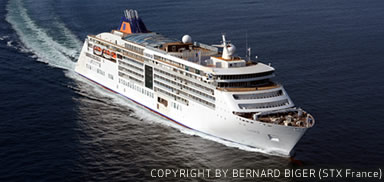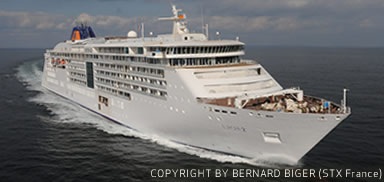Ocean cruise ships offer the opportunity to use sophisticated alternative technologies to reduce the emissions of pollutants and greenhouse gases. The chosen baseline for Ocean cruise ship is an “Exploration” vessel. This luxurious vessel aims at exploring new locations where the protection of environment is highly sensitive. Fitted with 12 decks, the ship can host 850 passengers and 400 crew members, and reach 19 knots. The hull design gives an overall length of 230m for 27m breadth, and a design draught of 6m.

2025 Ship Concept
Design of 2025 “Exploration” vessel relies on the use of liquefied natural gas instead of fuel oil for electrical production. Also, significant savings are forecasted on propulsion, notably thanks to sails and air lubrication. Downstream engines, waste heat recovery is made with Exhaust Gas Boilers and heat recovery loops. At sea, the wasted steam is converted into electricity with an Organic Rankine Cycle. Together with various electrical consumers optimisation, the 2025 design would see its energy consumption reduced by 20%. Use of LNG allows significant reduction pollutants air emissions (SOx -99%, NOx -80%, CO2 -20%).

2050 Ship Concept
Going further, in the version 2050 of the “Exploration” cruise ship, engines will be replaced by a hybrid DC architecture relying on fuel cells (fed with LNG) and batteries. In addition to 2025 waste heat recovery, cooling power could partly come from heat, thanks to absorption chiller. In addition to sails, new energy sources, such as waste gasification and solar panels will be implemented. On the hydrodynamic side, new POD generations, advanced air lubrication, hull coating and hull cleaning devices are expected. The resulting energy consumption would be half of the baseline ship one. This ship should be free of SOx and NOx emissions, and would have reduced its CO2 emissions by 70%.


